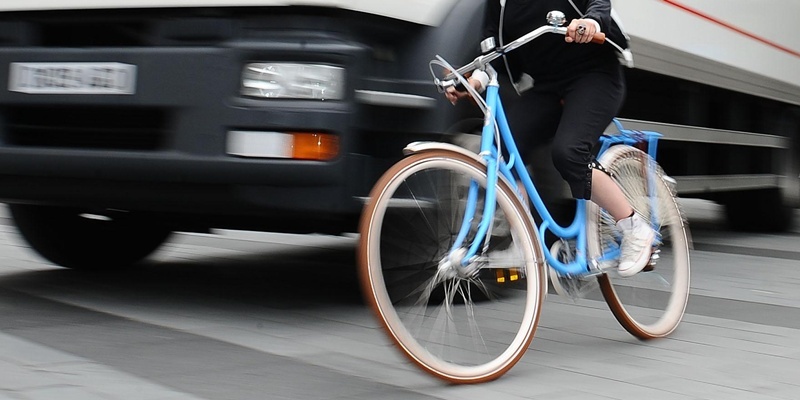It is environmentally friendly, inexpensive and keeps you fit: yet a new survey reveals many are deterred from cycling because of concerns about safety. Stefan Morkis finds out what is being done to put it back on track.
As the face of Channel 4 news, Jon Snow is best known for asking questions but last week it was the veteran journalist’s turn to answer them. The 62-year-old, who is president of the Cyclists Touring Club (CTC), told the House of Commons Transport Select Committee that efforts to promote cycling are being undermined because there is ”no cycling leadership from the state” to promote safety.
He said the country needs more dedicated cycle lanes to encourage people to get on their bikes and leave their cars at home.
Despite the benefits of cycling regarding personal fitness and in terms of reducing carbon emissions, the results of a new survey released on Wednesday reveal that many would-be cyclists share the newscaster’s concerns.
The poll was carried out on behalf of road safety charity Brake and solicitors Bold Burdon Kemp found that two out of three commuters believe roads are unfit for cycling and that more would cycle to work if the roads were safer.
Nearly half of the 1,550 adults questioned for the survey were regular cyclists but 64% said they only use their bike occasionally. Only 10% said it was used as their main form of transport for commuting.
The survey also showed that 35% would switch to cycling to work if the route was less dangerous and 46% would make other journeys by bike if roads were safer. Only 15% of those surveyed said they had widespread 20mph limits in their area.
Brake deputy chief executive Julie Townsend said: ”It’s positive the Government is working to encourage cycling to improve health and reduce pollution, but it must also ensure roads are safe for cyclists.”
According to the Scottish Government’s Cycling Action Plan, only 1% of trips made in Scotland use a bike.
The Government wants to increase that to 10% by 2020 and will spend £5.5 million over the next three years to improve Scotland’s cycling infrastructure. However, many cyclists believe still not enough is being done to convince people to swap their cars for bikes.
Chris Peck, policy co-ordinator with the CTC, said: ”On many major roads it is a very hostile environment and better designed spaces for cyclists are needed. That is very expensive but there are things that can be done that are better and cheaper, including better enforcement of traffic laws.
”A lot of our members complain about the aggressive and hostile behaviour from motorists. We’ve found this to be a real problem but the good thing about more enforcements is it will also cut down on bad cycling.”
Mr Peck added: ”In Scotland there is a target to get cycling up to 10% of all trips by 2020 but we are not on target to reach that.”
A Transport Scotland spokeswoman said: ”We recognise that a lack of confidence can be an issue when it comes to cycling on roads and are addressing this through a range of initiatives and investment to improve infrastructure.
”Since 2007 we have invested over £83 million on promoting active travel and improving facilities and infrastructure such as the expansion of the National Cycle Network. In February, an additional £20.25 million was announced for infrastructure to support active travel over the next three financial years.
”Fatal accidents on Scotland’s roads have fallen by 36% in the past decade, but we cannot afford to be complacent. That’s why last month Transport Secretary Keith Brown chaired a special cycle safety meeting, where it was agreed that partners would work together to make Scotland’s roads safer for cyclists.
”Speed limits on non-trunk roads are a matter for local authorities and we continue to urge that they seriously consider introducing 20mph zones in residential areas. Through Scottish Government funding, some councils have already been able to introduce these.”Comment: why I cycle to workIt’s a cold, dark night in late December and I’m racing home after a long day at our Kingsway offices in Dundee, writes Richard Rooney, Courier online editor.
I’m heading downhill, with a wind at my back, and things feel good.
But then I realise despite my wearing enough fluorescent clothing to make a dancer at an 80s disco night blush the driver approaching the T-junction on my left doesn’t see me and he’s going to pull out.
These are the private moments of terror that can make the commuting cyclist question his choice of transport. A bike is a lonely place to be when car wheels start screeching.
So why cycle to work?
There’s no single reason for my choosing to leave the car on the drive every day. Rocketing fuel costs certainly play a part, and the chance to grab some “free” exercise time is another huge bonus.
But and I must admit to being slightly reluctant about letting you all into the secret here the main reason is the sheer fun of it all.
Yes, you need to keep your wits about you and assume that you are as good as invisible to all other road users. Anticipating what the driver was going to do prevented the near-miss above becoming something more serious.
But the rewards far outweigh any negatives. I took the photo above on the morning Brake released its report. I can think of no better way to get to work.
We are blessed with miles of paths and relatively quiet roads in this area, and a bike offers the best way to enjoy them.
Email inboxes and all the other pressures of the modern workplace suddenly feel a long way off when I am pedalling beside the Tay.
